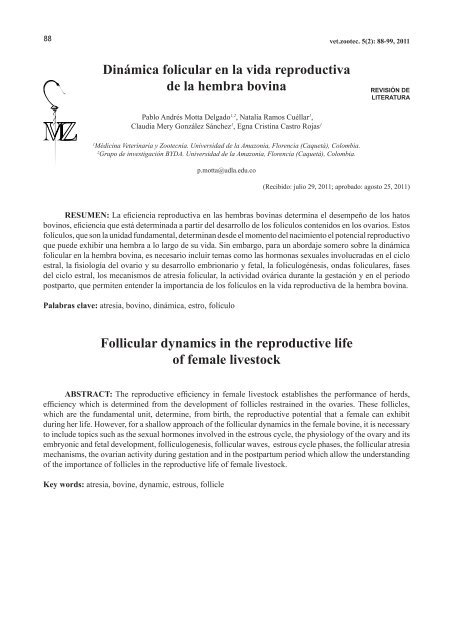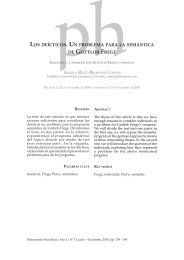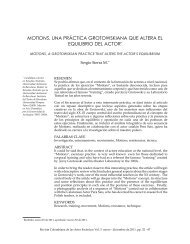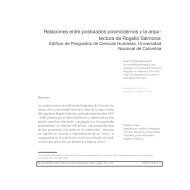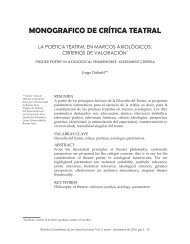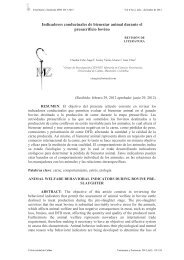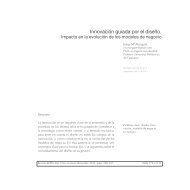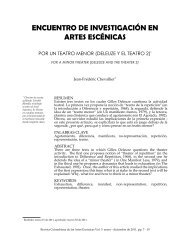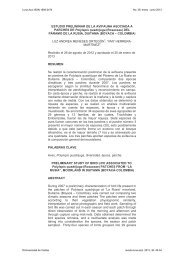Dinámica folicular en la vida reproductiva de la hembra bovina ...
Dinámica folicular en la vida reproductiva de la hembra bovina ...
Dinámica folicular en la vida reproductiva de la hembra bovina ...
Create successful ePaper yourself
Turn your PDF publications into a flip-book with our unique Google optimized e-Paper software.
88<br />
<strong>Dinámica</strong> <strong>folicu<strong>la</strong>r</strong> <strong>en</strong> <strong>la</strong> <strong>vida</strong> <strong>reproductiva</strong><br />
<strong>de</strong> <strong>la</strong> <strong>hembra</strong> <strong>bovina</strong><br />
Pablo Andrés Motta Delgado 1,2 , Natalia Ramos Cuél<strong>la</strong>r 1 ,<br />
C<strong>la</strong>udia Mery González Sánchez 1 , Egna Cristina Castro Rojas 1<br />
1 Médicina Veterinaria y Zootecnia. Universidad <strong>de</strong> <strong>la</strong> Amazonia, Flor<strong>en</strong>cia (Caquetá), Colombia.<br />
2 Grupo <strong>de</strong> investigación BYDA. Universidad <strong>de</strong> <strong>la</strong> Amazonia, Flor<strong>en</strong>cia (Caquetá), Colombia.<br />
p.motta@ud<strong>la</strong>.edu.co<br />
(Recibido: julio 29, 2011; aprobado: agosto 25, 2011)<br />
RESUMEN: La efici<strong>en</strong>cia <strong>reproductiva</strong> <strong>en</strong> <strong>la</strong>s <strong>hembra</strong>s <strong>bovina</strong>s <strong>de</strong>termina el <strong>de</strong>sempeño <strong>de</strong> los hatos<br />
bovinos, efici<strong>en</strong>cia que está <strong>de</strong>terminada a partir <strong>de</strong>l <strong>de</strong>sarrollo <strong>de</strong> los folículos cont<strong>en</strong>idos <strong>en</strong> los ovarios. Estos<br />
folículos, que son <strong>la</strong> unidad fundam<strong>en</strong>tal, <strong>de</strong>terminan <strong>de</strong>s<strong>de</strong> el mom<strong>en</strong>to <strong>de</strong>l nacimi<strong>en</strong>to el pot<strong>en</strong>cial reproductivo<br />
que pue<strong>de</strong> exhibir una <strong>hembra</strong> a lo <strong>la</strong>rgo <strong>de</strong> su <strong>vida</strong>. Sin embargo, para un abordaje somero sobre <strong>la</strong> dinámica<br />
<strong>folicu<strong>la</strong>r</strong> <strong>en</strong> <strong>la</strong> <strong>hembra</strong> <strong>bovina</strong>, es necesario incluir temas como <strong>la</strong>s hormonas sexuales involucradas <strong>en</strong> el ciclo<br />
estral, <strong>la</strong> fisiología <strong>de</strong>l ovario y su <strong>de</strong>sarrollo embrionario y fetal, <strong>la</strong> foliculogénesis, ondas <strong>folicu<strong>la</strong>r</strong>es, fases<br />
<strong>de</strong>l ciclo estral, los mecanismos <strong>de</strong> atresia <strong>folicu<strong>la</strong>r</strong>, <strong>la</strong> acti<strong>vida</strong>d ovárica durante <strong>la</strong> gestación y <strong>en</strong> el periodo<br />
postparto, que permit<strong>en</strong> <strong>en</strong>t<strong>en</strong><strong>de</strong>r <strong>la</strong> importancia <strong>de</strong> los folículos <strong>en</strong> <strong>la</strong> <strong>vida</strong> <strong>reproductiva</strong> <strong>de</strong> <strong>la</strong> <strong>hembra</strong> <strong>bovina</strong>.<br />
Pa<strong>la</strong>bras c<strong>la</strong>ve: atresia, bovino, dinámica, estro, folículo<br />
Follicu<strong>la</strong>r dynamics in the reproductive life<br />
of female livestock<br />
ABSTRACT: The reproductive effici<strong>en</strong>cy in female livestock establishes the performance of herds,<br />
effici<strong>en</strong>cy which is <strong>de</strong>termined from the <strong>de</strong>velopm<strong>en</strong>t of follicles restrained in the ovaries. These follicles,<br />
which are the fundam<strong>en</strong>tal unit, <strong>de</strong>termine, from birth, the reproductive pot<strong>en</strong>tial that a female can exhibit<br />
during her life. However, for a shallow approach of the follicu<strong>la</strong>r dynamics in the female bovine, it is necessary<br />
to inclu<strong>de</strong> topics such as the sexual hormones involved in the estrous cycle, the physiology of the ovary and its<br />
embryonic and fetal <strong>de</strong>velopm<strong>en</strong>t, folliculog<strong>en</strong>esis, follicu<strong>la</strong>r waves, estrous cycle phases, the follicu<strong>la</strong>r atresia<br />
mechanisms, the ovarian activity during gestation and in the postpartum period which allow the un<strong>de</strong>rstanding<br />
of the importance of follicles in the reproductive life of female livestock.<br />
Key words: atresia, bovine, dynamic, estrous, follicle<br />
vet.zootec. 5(2): 88-99, 2011<br />
REVISIÓN DE<br />
LITERATURA
Introducción<br />
El <strong>de</strong>sempeño <strong>de</strong> los hatos bovinos está<br />
<strong>de</strong>terminado por <strong>la</strong> efici<strong>en</strong>cia <strong>reproductiva</strong> <strong>de</strong> <strong>la</strong>s<br />
<strong>hembra</strong>s (Oliveira Filho et al., 1999; Webb et al.,<br />
1999; Ma<strong>la</strong>rd et al., 2001). La <strong>vida</strong> <strong>reproductiva</strong><br />
<strong>de</strong> <strong>la</strong> <strong>hembra</strong> <strong>bovina</strong> está marcada <strong>de</strong>s<strong>de</strong> los<br />
inicios <strong>de</strong> su <strong>vida</strong>, es <strong>de</strong>cir, <strong>de</strong>s<strong>de</strong> el <strong>de</strong>sarrollo<br />
fetal <strong>la</strong> <strong>hembra</strong> <strong>bovina</strong> inicia <strong>la</strong> preparación <strong>de</strong><br />
su sistema reproductivo, y al nacimi<strong>en</strong>to órganos<br />
como los ovarios ya ti<strong>en</strong><strong>en</strong> el pot<strong>en</strong>cial para<br />
<strong>la</strong> producción <strong>de</strong> ovocitos cont<strong>en</strong>idos <strong>en</strong> sus<br />
folículos (Roberts, 1971).<br />
En el ovario los folículos son <strong>la</strong> unidad<br />
fundam<strong>en</strong>tal <strong>de</strong>l mismo, y son estructuras<br />
<strong>de</strong>s<strong>en</strong>cad<strong>en</strong>antes <strong>de</strong> los procesos reproductivos y<br />
<strong>de</strong> <strong>la</strong>s fases <strong>de</strong>l ciclo estral. Estos procesos, según<br />
Roberts (1971), están mediados por <strong>la</strong> compleja<br />
interacción <strong>de</strong>l hipotá<strong>la</strong>mo-hipófisis-ovarios a<br />
partir <strong>de</strong> <strong>la</strong> liberación <strong>de</strong> hormonas al torr<strong>en</strong>te<br />
sanguíneo.<br />
La pres<strong>en</strong>te revisión, ti<strong>en</strong>e como objetivo<br />
compr<strong>en</strong><strong>de</strong>r <strong>la</strong> importancia <strong>de</strong> <strong>la</strong> dinámica<br />
<strong>folicu<strong>la</strong>r</strong> <strong>en</strong> <strong>la</strong> <strong>vida</strong> <strong>reproductiva</strong> <strong>de</strong> <strong>la</strong> <strong>hembra</strong><br />
<strong>bovina</strong>, por tanto, se abordan <strong>la</strong>s hormonas<br />
sexuales involucradas <strong>en</strong> el ciclo estral, el papel<br />
<strong>de</strong> los ovarios, el <strong>de</strong>sarrollo embrionario y fetal<br />
<strong>de</strong>l ovario, <strong>la</strong> <strong>en</strong>docrinología <strong>de</strong>l ciclo estral<br />
don<strong>de</strong> se incluye <strong>la</strong> foliculogénesis, <strong>la</strong>s ondas<br />
<strong>folicu<strong>la</strong>r</strong>es, <strong>la</strong>s fases <strong>de</strong>l ciclo estral, a<strong>de</strong>más <strong>de</strong><br />
los mecanismos <strong>de</strong> atresia <strong>folicu<strong>la</strong>r</strong>, <strong>la</strong> acti<strong>vida</strong>d<br />
ovárica <strong>en</strong> <strong>hembra</strong>s prepúberes, púberes, durante<br />
<strong>la</strong> gestación y <strong>en</strong> el periodo postparto.<br />
Hormonas sexuales involucradas<br />
<strong>en</strong> el ciclo estral<br />
La dinámica <strong>folicu<strong>la</strong>r</strong> <strong>en</strong> <strong>la</strong> <strong>hembra</strong> <strong>bovina</strong> es<br />
<strong>de</strong>s<strong>en</strong>cad<strong>en</strong>ante <strong>de</strong> los procesos reproductivos<br />
y <strong>de</strong> <strong>la</strong>s fases <strong>de</strong>l ciclo estral, sin embargo,<br />
estos ev<strong>en</strong>tos están regu<strong>la</strong>dos por un complejo<br />
conjunto <strong>de</strong> factores que se interre<strong>la</strong>cionan y<br />
permit<strong>en</strong> que se pres<strong>en</strong>te <strong>la</strong> ovu<strong>la</strong>ción como punto<br />
final <strong>de</strong>l ciclo estral y punto inicial <strong>en</strong> <strong>la</strong> <strong>vida</strong><br />
<strong>reproductiva</strong> <strong>de</strong> <strong>la</strong> <strong>hembra</strong> <strong>bovina</strong>. Entre estos<br />
Motta Delgado et al.<br />
89<br />
factores juega un papel importante <strong>la</strong> influ<strong>en</strong>cia<br />
<strong>de</strong> <strong>la</strong>s hormonas sexuales involucradas <strong>en</strong> el ciclo<br />
estral, hormonas que se <strong>en</strong>cu<strong>en</strong>tran regu<strong>la</strong>das por<br />
el sistema neuro<strong>en</strong>docrino <strong>de</strong>l eje hipotá<strong>la</strong>mohipófisis-ovarios-útero.<br />
Para Arthur (1975) y Rathbone et al. (2001), los<br />
ciclos reproductivos y sus cambios están regu<strong>la</strong>dos<br />
por <strong>la</strong> interacción <strong>de</strong>l sistema nervioso c<strong>en</strong>tral con<br />
<strong>la</strong>s hormonas <strong>de</strong> <strong>la</strong> glándu<strong>la</strong> pituitaria anterior y<br />
los ovarios. Para Callejas (1995), los estímulos<br />
<strong>de</strong>l medio externo, actúan sobre estructuras<br />
nerviosas extrahipotalámicas como <strong>la</strong> glándu<strong>la</strong><br />
pineal que a su vez ejerc<strong>en</strong> un efecto <strong>de</strong> estímulo<br />
sobre el hipotá<strong>la</strong>mo, el cual <strong>en</strong> sus neuronas<br />
se <strong>en</strong>carga <strong>de</strong> <strong>la</strong> producción <strong>de</strong> <strong>la</strong> hormona<br />
liberadora <strong>de</strong> gonadotropina (GnRH) que, según<br />
C<strong>la</strong>rke (1988), es liberada <strong>en</strong> forma <strong>de</strong> pulsos.<br />
Según Arthur (1975), C<strong>la</strong>rke (1988) y Callejas<br />
(1995), <strong>la</strong> GnRH <strong>en</strong> <strong>la</strong> emin<strong>en</strong>cia media, difun<strong>de</strong><br />
a los capi<strong>la</strong>res <strong>de</strong>l sistema portahipofisiario y<br />
<strong>de</strong> allí hasta <strong>la</strong>s célu<strong>la</strong>s <strong>de</strong> <strong>la</strong> ad<strong>en</strong>ohipófisis <strong>en</strong><br />
don<strong>de</strong> estimu<strong>la</strong> <strong>la</strong> síntesis <strong>de</strong> <strong>la</strong> hormona folículo<br />
estimu<strong>la</strong>nte (FSH) y <strong>la</strong> hormona luteinizante<br />
(LH), hormonas relevantes <strong>en</strong> el control <strong>de</strong>l<br />
ciclo estral porque, según Arthur (1975), actúan<br />
sobre el ovario y causan <strong>la</strong> maduración <strong>de</strong>l<br />
folículo y secreción <strong>de</strong> estróg<strong>en</strong>o. Para Callejas<br />
(1995), <strong>la</strong> FSH es <strong>la</strong> responsable <strong>de</strong>l proceso<br />
<strong>de</strong> esteroi<strong>de</strong>génesis (<strong>folicu<strong>la</strong>r</strong>) “producción<br />
<strong>de</strong> estróg<strong>en</strong>os”, crecimi<strong>en</strong>to y maduración <strong>de</strong>l<br />
folículo dominante; <strong>la</strong> LH está involucrada <strong>en</strong> el<br />
proceso <strong>de</strong> esteroi<strong>de</strong>génesis (luteal) “liberación<br />
<strong>de</strong> progesterona”, ovu<strong>la</strong>ción, formación y<br />
mant<strong>en</strong>imi<strong>en</strong>to <strong>de</strong>l cuerpo lúteo. Estas dos<br />
hormonas son secretadas a <strong>la</strong> corri<strong>en</strong>te sanguínea<br />
por medio <strong>de</strong> pulsos que varían <strong>en</strong> frecu<strong>en</strong>cia y<br />
amplitud (Hauger et al., 1977; Rahe et al., 1980;<br />
Wright & Malmo, 1992), y son regu<strong>la</strong>das por el<br />
sistema tónico y cíclico ubicado <strong>en</strong> el hipotá<strong>la</strong>mo.<br />
Según Callejas (1995), el sistema tónico produce<br />
el nivel basal circu<strong>la</strong>nte, siempre constante <strong>de</strong><br />
hormonas hipofisiarias <strong>en</strong>cargadas <strong>de</strong>l <strong>de</strong>sarrollo<br />
<strong>de</strong> los elem<strong>en</strong>tos germinales y <strong>en</strong>docrinos <strong>de</strong>l<br />
ovario. El sistema cíclico es <strong>de</strong> función aguda,<br />
si<strong>en</strong>do activo solo 12 a 24 horas <strong>en</strong> cada uno<br />
<strong>de</strong> los ciclos reproductivos <strong>de</strong> <strong>la</strong>s <strong>hembra</strong>s<br />
“g<strong>en</strong>eralm<strong>en</strong>te <strong>en</strong> el estro”. El modo cíclico ti<strong>en</strong>e<br />
vet.zootec. 5(2): 88-99, 2011
90<br />
<strong>la</strong> función <strong>de</strong> g<strong>en</strong>erar <strong>la</strong> <strong>de</strong>hisc<strong>en</strong>cia <strong>folicu<strong>la</strong>r</strong>.<br />
La oxitocina almac<strong>en</strong>ada <strong>en</strong> <strong>la</strong> neurohipófisis<br />
intervi<strong>en</strong>e <strong>en</strong> <strong>la</strong> luteólisis permiti<strong>en</strong>do <strong>la</strong> posterior<br />
ovu<strong>la</strong>ción <strong>de</strong>l folículo dominante.<br />
Los estróg<strong>en</strong>os son hormonas esteroi<strong>de</strong>as<br />
producidos por los folículos ováricos <strong>en</strong><br />
maduración que ti<strong>en</strong><strong>en</strong> influ<strong>en</strong>cia sobre los<br />
oviductos, el útero, <strong>la</strong> vagina, <strong>la</strong> vulva, así como<br />
<strong>en</strong> el sistema nervioso c<strong>en</strong>tral y el hipotá<strong>la</strong>mo,<br />
estimu<strong>la</strong>ndo <strong>la</strong> conducta <strong>de</strong> celo y ejerci<strong>en</strong>do<br />
retroalim<strong>en</strong>tación negativa sobre el c<strong>en</strong>tro<br />
tónico y positivo sobre el c<strong>en</strong>tro cíclico; así,<br />
según Scho<strong>en</strong>emann et al. (1985), el estróg<strong>en</strong>o<br />
<strong>en</strong> aus<strong>en</strong>cia <strong>de</strong> progesterona, estimu<strong>la</strong> <strong>la</strong><br />
síntesis para receptores <strong>de</strong> GnRH <strong>en</strong> <strong>la</strong> hipófisis<br />
que, para Kesner et al. (1981), <strong>la</strong> vuelve más<br />
s<strong>en</strong>sible a <strong>la</strong> GnRH estimu<strong>la</strong>ndo, según Walters<br />
& Schall<strong>en</strong>berger (1984) y Hurnik, (1987), <strong>la</strong><br />
síntesis <strong>de</strong>l pico <strong>de</strong> LH que, según lo refer<strong>en</strong>ciado<br />
por Karsch (1987), C<strong>la</strong>rke (1988), Mukasa-<br />
Mugerwa (1989) y Karsch et al. (1997), permit<strong>en</strong><br />
<strong>la</strong> ovu<strong>la</strong>ción <strong>de</strong>l folículo terciario o <strong>de</strong> Graaf.<br />
Roberts (1971) y Callejas (1995), refier<strong>en</strong> que <strong>la</strong><br />
progesterona es producida <strong>en</strong> el cuerpo lúteo por<br />
acción <strong>de</strong> <strong>la</strong> LH y ejerce su acción <strong>de</strong>spués <strong>de</strong> que<br />
los órganos diana han sido estimu<strong>la</strong>dos por los<br />
estróg<strong>en</strong>os, preparando el útero principalm<strong>en</strong>te<br />
para <strong>la</strong> gestación; según Arthur (1975), <strong>en</strong>tre los<br />
días 16 a 19 <strong>de</strong>l ciclo estral hay un <strong>de</strong>sc<strong>en</strong>so <strong>de</strong><br />
los niveles <strong>de</strong> progesterona p<strong>la</strong>smática <strong>de</strong>bido al<br />
increm<strong>en</strong>to <strong>en</strong> <strong>la</strong> conc<strong>en</strong>tración <strong>de</strong> estróg<strong>en</strong>os. La<br />
inhibina, es una hormona proteica producida por<br />
<strong>la</strong>s célu<strong>la</strong>s <strong>de</strong> <strong>la</strong> granulosa <strong>de</strong>l folículo ovárico e<br />
intervi<strong>en</strong>e <strong>en</strong> <strong>la</strong> regu<strong>la</strong>ción <strong>de</strong> <strong>la</strong> FSH, reduci<strong>en</strong>do<br />
<strong>la</strong> secreción <strong>de</strong> esta última por retroalim<strong>en</strong>tación<br />
negativa sobre <strong>la</strong> hipófisis. El útero se <strong>en</strong>carga<br />
<strong>de</strong> <strong>la</strong> producción <strong>de</strong> <strong>la</strong> prostag<strong>la</strong>ndina F2 alfa<br />
(PGF 2α ), que regu<strong>la</strong> el ciclo estral a partir <strong>de</strong><br />
su efecto luteolítico, a<strong>de</strong>más intervi<strong>en</strong>e <strong>en</strong> el<br />
mecanismo <strong>de</strong> ovu<strong>la</strong>ción y <strong>de</strong> parto.<br />
Fisiología <strong>de</strong>l ovario<br />
El ovario a<strong>de</strong>más <strong>de</strong> producir y secretar <strong>la</strong>s<br />
hormonas gonadales <strong>reproductiva</strong>s, produce<br />
óvulos (Roberts, 1971). Las hormonas<br />
<strong>Dinámica</strong> <strong>folicu<strong>la</strong>r</strong> <strong>en</strong> <strong>la</strong> <strong>vida</strong> <strong>reproductiva</strong> <strong>de</strong> <strong>la</strong> <strong>hembra</strong> <strong>bovina</strong><br />
producidas por el ovario son: los estróg<strong>en</strong>os,<br />
los progestág<strong>en</strong>os, los andróg<strong>en</strong>os y <strong>la</strong> re<strong>la</strong>xina<br />
(hormona no esteroidal) (Turner, 1961; Mellin<br />
& Erb, 1965). Para Johnson (2003), el ovario<br />
es un órgano dinámico, que provee un ambi<strong>en</strong>te<br />
a<strong>de</strong>cuado para <strong>la</strong> producción <strong>de</strong> sustancias como<br />
<strong>la</strong>s hormonas, factores <strong>de</strong> crecimi<strong>en</strong>to y liberación<br />
<strong>de</strong> gametos viables, estos últimos son cont<strong>en</strong>idos<br />
<strong>de</strong>s<strong>de</strong> el periodo fetal <strong>en</strong> los folículos.<br />
Desarrollo embrionario y fetal <strong>de</strong>l ovario<br />
bovino (ovogénesis u oogénesis)<br />
Des<strong>de</strong> <strong>la</strong>s primeras semanas <strong>de</strong> <strong>de</strong>sarrollo<br />
embrionario, <strong>la</strong>s gran<strong>de</strong>s célu<strong>la</strong>s germinales<br />
primitivas l<strong>la</strong>madas célu<strong>la</strong>s germinales<br />
primordiales pued<strong>en</strong> ser id<strong>en</strong>tificadas <strong>en</strong><br />
<strong>en</strong>dob<strong>la</strong>sto extraembrional caudal (Mauleon,<br />
1969). Esas célu<strong>la</strong>s germinales primordiales<br />
migran por movimi<strong>en</strong>tos ameboi<strong>de</strong>s a través <strong>de</strong>l<br />
mes<strong>en</strong>terio <strong>de</strong> <strong>la</strong> cresta g<strong>en</strong>ital (B<strong>la</strong>ndau, 1965),<br />
según Erickson (1966) esa migración ocurre a los<br />
35 días <strong>de</strong> gestación, mi<strong>en</strong>tras <strong>la</strong> difer<strong>en</strong>ciación<br />
sexual <strong>de</strong>l embrión bovino ocurre a los 45 días<br />
<strong>de</strong> gestación (Mauleon, 1969). El periodo <strong>de</strong><br />
mitosis oogonial, ocurre <strong>en</strong>tre los días 45 a 110<br />
<strong>de</strong> gestación y es el periodo <strong>de</strong> mayor oogénesis.<br />
En el segundo tercio <strong>de</strong> <strong>la</strong> gestación, el ovario<br />
bovino ya está repleto <strong>de</strong> oogonias y estas están<br />
cont<strong>en</strong>idas <strong>en</strong> folículos primordiales (preantrales,<br />
con una única capa <strong>de</strong> célu<strong>la</strong>s <strong>de</strong> <strong>la</strong> granulosa).<br />
En el último tercio <strong>de</strong> <strong>la</strong> gestación, ocurr<strong>en</strong><br />
los estadios iniciales <strong>de</strong> crecimi<strong>en</strong>to <strong>folicu<strong>la</strong>r</strong><br />
(Erickson, 1966; Marion et al., 1968). Para<br />
Erickson (1966), al nacimi<strong>en</strong>to el número <strong>de</strong><br />
ovocitos <strong>en</strong> los ovarios es ampliam<strong>en</strong>te variable<br />
<strong>en</strong>tre individuos, pued<strong>en</strong> existir <strong>hembra</strong>s <strong>de</strong> 0<br />
(completam<strong>en</strong>te estéril) hasta 700000 folículos<br />
<strong>en</strong> los ovarios, estos gradualm<strong>en</strong>te <strong>de</strong>jan su estado<br />
<strong>de</strong> <strong>la</strong>t<strong>en</strong>cia e inician el <strong>de</strong>sarrollo <strong>de</strong> folículos<br />
antrales. Una vez que se inicia el <strong>de</strong>sarrollo<br />
ocurrirá <strong>la</strong> ovu<strong>la</strong>ción o <strong>la</strong> atresia.<br />
Apar<strong>en</strong>tem<strong>en</strong>te, son necesarios 60 días para que<br />
un folículo primordial activado llegue al tamaño<br />
<strong>de</strong> ovu<strong>la</strong>ción (Lussier et al., 1987). En este
periodo, sigui<strong>en</strong>do un patrón <strong>de</strong> ondas <strong>folicu<strong>la</strong>r</strong>es<br />
(Wiltbank et al., 1996), ocurr<strong>en</strong> varias fases <strong>de</strong><br />
crecimi<strong>en</strong>to y atresia <strong>folicu<strong>la</strong>r</strong> con <strong>la</strong> subsecu<strong>en</strong>te<br />
maduración o <strong>de</strong>g<strong>en</strong>eración oocitaria (Dayan,<br />
2001).<br />
Foliculogénesis<br />
El folículo ovárico es <strong>la</strong> unidad estructural<br />
y funcional <strong>de</strong>l ovario, proporcionando un<br />
ambi<strong>en</strong>te a<strong>de</strong>cuado para el crecimi<strong>en</strong>to, ev<strong>en</strong>tual<br />
ovu<strong>la</strong>ción <strong>de</strong>l ovocito que conti<strong>en</strong>e y formación<br />
<strong>de</strong> un embrión a partir <strong>de</strong> <strong>la</strong> fecundación<br />
(Cortvrindt & Smitz, 2001; Find<strong>la</strong>y et al., 2009).<br />
La foliculogénesis es un proceso altam<strong>en</strong>te<br />
selectivo don<strong>de</strong> usualm<strong>en</strong>te solo un folículo<br />
asume dominancia y el <strong>de</strong>stino <strong>de</strong>l resto <strong>de</strong> los<br />
folículos es <strong>la</strong> atresia mediada por apoptosis; el<br />
mayor tipo <strong>de</strong> célu<strong>la</strong>s que sufr<strong>en</strong> este proceso son<br />
<strong>la</strong>s célu<strong>la</strong>s <strong>de</strong> <strong>la</strong> granulosa (Hsueh et al., 1994).<br />
Para Roberts (1971) y Knopf et al. (1989), <strong>la</strong><br />
foliculogénesis ocurre <strong>en</strong> estado fetal, animales<br />
prepúberes y durante <strong>la</strong> gestación. Un folículo<br />
primordial está compuesto por un ovocito con<br />
crecimi<strong>en</strong>to <strong>de</strong>t<strong>en</strong>ido antes <strong>de</strong>l nacimi<strong>en</strong>to<br />
<strong>en</strong> <strong>la</strong> fase <strong>de</strong> diplot<strong>en</strong>o <strong>de</strong> <strong>la</strong> profase I <strong>de</strong> <strong>la</strong><br />
meiosis, ro<strong>de</strong>ado por una so<strong>la</strong> capa <strong>de</strong> célu<strong>la</strong>s<br />
<strong>de</strong> <strong>la</strong> pregranulosa (Nilsson et al, 2001). Según<br />
Roberts (1971) y Fortune (2002), <strong>la</strong> formación <strong>de</strong><br />
folículos primordiales ocurre durante el periodo<br />
fetal. Asimismo, Roberts (1971) refiere que el<br />
crecimi<strong>en</strong>to <strong>folicu<strong>la</strong>r</strong>, <strong>de</strong>sarrollo a un folículo <strong>de</strong><br />
Graaf y ovu<strong>la</strong>ción ocurre so<strong>la</strong>m<strong>en</strong>te <strong>en</strong> <strong>hembra</strong>s<br />
vacías <strong>de</strong>spués <strong>de</strong> <strong>la</strong> pubertad y durante el ciclo<br />
reproductivo.<br />
Para Ginther (2000), el <strong>de</strong>sarrollo y <strong>la</strong> atresia<br />
<strong>folicu<strong>la</strong>r</strong> están regu<strong>la</strong>das por <strong>la</strong> síntesis <strong>de</strong> estradiol<br />
<strong>en</strong> <strong>la</strong>s célu<strong>la</strong>s <strong>de</strong> <strong>la</strong> granulosa, sin embargo para<br />
Faes et al. (2007), el estróg<strong>en</strong>o y <strong>la</strong> progesterona<br />
están re<strong>la</strong>cionadas con <strong>la</strong> calidad <strong>folicu<strong>la</strong>r</strong>. No<br />
obstante, para Basini et al. (1998), otros factores<br />
intraováricos no esteroidales también sintetizados<br />
por <strong>la</strong>s célu<strong>la</strong>s <strong>de</strong> <strong>la</strong> granulosa están involucrados<br />
<strong>en</strong> <strong>la</strong> fisiología ovárica.<br />
En <strong>la</strong>s observaciones <strong>de</strong> Jolly et al. (1997), <strong>la</strong> LH<br />
estimu<strong>la</strong> el AMPc <strong>en</strong> <strong>la</strong>s célu<strong>la</strong>s <strong>de</strong> <strong>la</strong> granulosa<br />
Motta Delgado et al.<br />
91<br />
so<strong>la</strong>m<strong>en</strong>te <strong>en</strong> folículos con un diámetro mayor a<br />
nueve milímetros <strong>en</strong> taurinos y seis milímetros <strong>en</strong><br />
cebuínos, probando así, que los folículos mayores<br />
a este diámetro adquier<strong>en</strong> receptores para LH y,<br />
por tanto, capacidad ovu<strong>la</strong>toria. De esta forma, el<br />
tamaño <strong>de</strong> los folículos influ<strong>en</strong>cia el pot<strong>en</strong>cial <strong>de</strong><br />
<strong>de</strong>sarrollo y el diámetro <strong>de</strong> los ovocitos (Witt &<br />
Kruip, 2001).<br />
Ondas <strong>folicu<strong>la</strong>r</strong>es<br />
Ginther et al. (1989a), Adams et al. (1992), Bó<br />
et al. (1994) y Wiltbank et al. (1996), sugier<strong>en</strong><br />
que el crecimi<strong>en</strong>to <strong>de</strong> folículos bovinos ocurre<br />
<strong>en</strong> un patrón d<strong>en</strong>ominado ondas <strong>de</strong> crecimi<strong>en</strong>to<br />
<strong>folicu<strong>la</strong>r</strong>.<br />
Rajakoski (1960), basado <strong>en</strong> estudios histológicos<br />
<strong>de</strong> ovarios, propuso <strong>la</strong> hipótesis <strong>de</strong> ocurr<strong>en</strong>cia<br />
<strong>de</strong> dos ondas <strong>de</strong> crecimi<strong>en</strong>to <strong>folicu<strong>la</strong>r</strong> durante<br />
el ciclo estral bovino, hipótesis reafirmada<br />
mediante ultrasonografía por Binelli (2000) y<br />
Borges et al. (2001), a<strong>de</strong>más <strong>de</strong>terminaron que<br />
durante cada onda <strong>de</strong> crecimi<strong>en</strong>to <strong>folicu<strong>la</strong>r</strong> existe<br />
una pob<strong>la</strong>ción <strong>de</strong> folículos pequeños, medianos<br />
y gran<strong>de</strong>s <strong>en</strong> cada ovario, <strong>de</strong> los cuáles uno se<br />
torna dominante; según Pierson & Ginther<br />
(1987), mediante un proceso <strong>de</strong> selección hasta<br />
el diámetro preovu<strong>la</strong>torio y g<strong>en</strong>erando <strong>la</strong> atresia<br />
<strong>de</strong> los folículos pequeños<br />
En <strong>la</strong> dinámica <strong>folicu<strong>la</strong>r</strong> ovárica pued<strong>en</strong> ocurrir<br />
<strong>de</strong> una a cuatro ondas <strong>de</strong> crecimi<strong>en</strong>to <strong>folicu<strong>la</strong>r</strong><br />
(Ginther et al., 1989a), es así que para Savio et<br />
al. (1988), <strong>en</strong> el 81% <strong>de</strong> los casos suced<strong>en</strong> dos<br />
ondas, también reportadas por Pierson & Ginther<br />
(1987), Binelli (2000) y Borges et al. (2001);<br />
sin embargo, Sirois & Fortune (1988), reportan<br />
que <strong>en</strong> el 80% <strong>de</strong> los casos ocurr<strong>en</strong> tres ondas<br />
<strong>folicu<strong>la</strong>r</strong>es, hal<strong>la</strong>das a<strong>de</strong>más por Binelli (2000) y<br />
Borges et al. (2001).<br />
Exist<strong>en</strong> difer<strong>en</strong>cias <strong>en</strong> <strong>la</strong> dinámica <strong>folicu<strong>la</strong>r</strong> <strong>en</strong>tre<br />
Bos taurus taurus (taurino) y Bos taurus indicus<br />
(cebuíno) (Tab<strong>la</strong> 1), particu<strong>la</strong>ridad observada <strong>en</strong><br />
el número <strong>de</strong> ondas <strong>de</strong> crecimi<strong>en</strong>to <strong>folicu<strong>la</strong>r</strong> por<br />
ciclo estral, capacidad <strong>de</strong> secretar LH, área <strong>de</strong>l<br />
vet.zootec. 5(2): 88-99, 2011
92<br />
tejido luteal, diámetro <strong>folicu<strong>la</strong>r</strong> <strong>en</strong> el mom<strong>en</strong>to <strong>de</strong><br />
<strong>la</strong> diverg<strong>en</strong>cia y <strong>en</strong> <strong>la</strong> ovu<strong>la</strong>ción (Figueiredo et<br />
al., 1997; Pinheiro et al., 1998; Baruselli et al.,<br />
2007). En novil<strong>la</strong>s Bos taurus indicus, Rho<strong>de</strong>s et<br />
al. (1995), Figueiredo et al. (1997), Viana et al.<br />
(2000) y Luiz (2002), reportan que <strong>la</strong> dinámica<br />
<strong>folicu<strong>la</strong>r</strong> es caracterizada por <strong>la</strong> pres<strong>en</strong>cia <strong>de</strong> dos<br />
ondas (33%) y tres ondas (57,1%), reportando<br />
hasta cuatro ondas por ciclo <strong>en</strong> Brahman, Neloré y<br />
Gyr. Savio et al. (1988), Sirois & Fortune (1988),<br />
Ginther et al. (1989a) y Wolf<strong>en</strong>son et al. (2004),<br />
refier<strong>en</strong> que <strong>en</strong> animales <strong>de</strong> <strong>la</strong> raza Holstein (Bos<br />
taurus taurus) predominan <strong>de</strong> dos a tres ondas por<br />
<strong>Dinámica</strong> <strong>folicu<strong>la</strong>r</strong> <strong>en</strong> <strong>la</strong> <strong>vida</strong> <strong>reproductiva</strong> <strong>de</strong> <strong>la</strong> <strong>hembra</strong> <strong>bovina</strong><br />
ciclo estral. Según Carvalho et al. (2008), a<strong>de</strong>más<br />
<strong>de</strong> <strong>la</strong> difer<strong>en</strong>cia <strong>en</strong> el número <strong>de</strong> ondas <strong>folicu<strong>la</strong>r</strong>es,<br />
<strong>la</strong>s <strong>hembra</strong>s Bos taurus indicus reclutan mayor<br />
número <strong>de</strong> folículos por onda <strong>de</strong> crecimi<strong>en</strong>to<br />
<strong>folicu<strong>la</strong>r</strong> que <strong>la</strong>s <strong>hembra</strong>s Bos taurus taurus:<br />
33,4±3,2 versus 25,4±2,5, respectivam<strong>en</strong>te. En<br />
<strong>hembra</strong>s taurinas con dos ondas <strong>de</strong> crecimi<strong>en</strong>to<br />
<strong>folicu<strong>la</strong>r</strong> el diámetro <strong>de</strong>l folículo dominante es<br />
<strong>de</strong> 17,1 y 16,5 mm para <strong>la</strong> primera y segunda<br />
onda; <strong>en</strong> cebuínas, los diámetros fueron <strong>de</strong> 11,3 y<br />
12,1 mm, respectivam<strong>en</strong>te (Ginther et al., 1989a;<br />
Figueiredo et al., 1997).<br />
Tab<strong>la</strong> 1. <strong>Dinámica</strong> <strong>folicu<strong>la</strong>r</strong> <strong>en</strong> Bos taurus taurus (taurino) y Bos taurus indicus (cebuíno).<br />
Subespecie Raza Refer<strong>en</strong>cia<br />
Indicus<br />
Taurus<br />
Vacas<br />
Guzerá<br />
Vacas<br />
Gyr<br />
Vacas<br />
Neloré<br />
Vacas<br />
Holstein<br />
Coutinho<br />
et al.<br />
(2007)<br />
Viana et<br />
al. (1999)<br />
Figueiredo<br />
et al.<br />
(1997)<br />
Ginther et<br />
al. (1989a)<br />
Sirois &<br />
Fortune<br />
(1988)<br />
Ondas (%)<br />
2 3 4<br />
Folículo<br />
preovu<strong>la</strong>torio<br />
(mm)<br />
37,5 50 12,5 14,4<br />
83,3 16,7<br />
Para Bó et al. (1994), <strong>en</strong>tre el día uno a tres<br />
<strong>de</strong>spués <strong>de</strong>l estro emerge una onda <strong>de</strong> folículos<br />
que varía <strong>de</strong> 10 a 50 con un tamaño <strong>de</strong> dos a<br />
tres milímetros, parte <strong>de</strong> los cuales continúan<br />
creci<strong>en</strong>do hasta los cuatro y seis milímetros, <strong>de</strong><br />
estos, <strong>en</strong>tre dos y cinco sigu<strong>en</strong> creci<strong>en</strong>do según<br />
Ginther et al. (1996), a partir <strong>de</strong> <strong>la</strong> transición<br />
<strong>de</strong> FSH a LH, don<strong>de</strong> ocurre <strong>la</strong> diverg<strong>en</strong>cia <strong>de</strong>l<br />
folículo dominante (8,5 mm <strong>en</strong> taurinos y 6,2 mm<br />
<strong>en</strong> cebuínos) (Baruselli et al., 2007), g<strong>en</strong>erando<br />
<strong>la</strong> regresión <strong>de</strong> los folículos m<strong>en</strong>ores, sin<br />
81<br />
60 26,67<br />
80<br />
2 ondas:<br />
12,05<br />
3 ondas:<br />
11,61<br />
Folículos<br />
por onda<br />
33,4±3,2<br />
Folículo<br />
dominante<br />
(mm)<br />
1 ª<br />
onda<br />
2 ª<br />
onda<br />
17,1 16,5<br />
25,4±2,5 11,3 12,1<br />
embargo, este folículo inicia su atresia luego <strong>de</strong><br />
<strong>la</strong> fase estática. Para Silcoux et al. (1993), <strong>en</strong> <strong>la</strong><br />
primera onda <strong>de</strong> crecimi<strong>en</strong>to <strong>folicu<strong>la</strong>r</strong>, <strong>la</strong> fase <strong>de</strong><br />
crecimi<strong>en</strong>to va <strong>de</strong>s<strong>de</strong> <strong>la</strong> emerg<strong>en</strong>cia hasta cerca<br />
<strong>de</strong>l octavo al décimo día y <strong>la</strong> fase <strong>de</strong> regresión<br />
ocurre <strong>de</strong>spués <strong>de</strong>l décimo día, para <strong>hembra</strong>s que<br />
pres<strong>en</strong>tan dos ondas <strong>de</strong> crecimi<strong>en</strong>to <strong>folicu<strong>la</strong>r</strong>,<br />
mi<strong>en</strong>tras que <strong>en</strong> <strong>la</strong>s <strong>de</strong> tres ondas <strong>de</strong> crecimi<strong>en</strong>to<br />
<strong>folicu<strong>la</strong>r</strong> se ti<strong>en</strong>e <strong>de</strong>l sexto al séptimo día <strong>de</strong><br />
estática y séptimo a octavo día <strong>de</strong> regresión.
Según Savio et al. (1988) y Sirois & Fortune<br />
(1988), <strong>en</strong> animales que pres<strong>en</strong>tan ciclo estral <strong>de</strong><br />
dos ondas <strong>de</strong> crecimi<strong>en</strong>to <strong>folicu<strong>la</strong>r</strong> el reclutami<strong>en</strong>to<br />
<strong>de</strong> <strong>la</strong> primera onda es id<strong>en</strong>tificada <strong>en</strong> el día <strong>de</strong> <strong>la</strong><br />
ovu<strong>la</strong>ción, al día tres el folículo dominante está<br />
pres<strong>en</strong>te alcanzando el diámetro preovu<strong>la</strong>torio a<br />
los seis días, este folículo permanece estático hasta<br />
el inicio <strong>de</strong> <strong>la</strong> segunda onda <strong>en</strong> el día diez <strong>de</strong>spués<br />
<strong>de</strong> <strong>la</strong> ovu<strong>la</strong>ción, don<strong>de</strong> se produce el folículo <strong>de</strong><br />
Graaf y ovu<strong>la</strong>torio. Asimismo, refier<strong>en</strong> que <strong>en</strong> un<br />
ciclo <strong>de</strong> tres ondas <strong>folicu<strong>la</strong>r</strong>es <strong>la</strong> fase estática <strong>de</strong>l<br />
folículo dominante <strong>de</strong> <strong>la</strong> primera onda <strong>folicu<strong>la</strong>r</strong><br />
es más corta y <strong>la</strong> fase luteal es más <strong>la</strong>rga, <strong>en</strong> estos<br />
casos <strong>la</strong> tercera onda se inicia al día 16 y <strong>de</strong> esta<br />
se produce <strong>la</strong> ovu<strong>la</strong>ción. Sin embargo, Bó et al.<br />
(1995), refier<strong>en</strong> que <strong>en</strong> el octavo día <strong>de</strong>l ciclo<br />
estral (o sexto, por <strong>la</strong> variación <strong>en</strong> el número <strong>de</strong><br />
ondas) ocurre <strong>la</strong> emerg<strong>en</strong>cia <strong>de</strong> <strong>la</strong> segunda onda<br />
<strong>de</strong> crecimi<strong>en</strong>to <strong>folicu<strong>la</strong>r</strong> y el proceso se reinicia;<br />
el folículo dominante <strong>de</strong> esa segunda onda<br />
regresiona (si hay tres ondas) o se torna folículo<br />
ovu<strong>la</strong>torio si sslo ocurr<strong>en</strong> dos ondas.<br />
Variaciones <strong>en</strong> <strong>la</strong> dinámica <strong>folicu<strong>la</strong>r</strong> pued<strong>en</strong> <strong>de</strong>berse<br />
a factores como <strong>la</strong> dieta, manejo, producción <strong>de</strong><br />
leche, periodo <strong>de</strong> <strong>la</strong>ctancia, y postparto (Ginther<br />
et al., 1996). La dieta pue<strong>de</strong> afectar el patrón<br />
<strong>de</strong> ondas <strong>de</strong> crecimi<strong>en</strong>to <strong>folicu<strong>la</strong>r</strong>, <strong>de</strong>bido a<br />
que una nutrición pobre está asociada a bajas<br />
conc<strong>en</strong>traciones <strong>de</strong> IGF-I circu<strong>la</strong>nte (Murphy et<br />
al., 1990), reducción <strong>de</strong>l diámetro <strong>de</strong>l folículo<br />
dominante <strong>de</strong> todas <strong>la</strong>s ondas y también reduce<br />
el tiempo <strong>de</strong> persist<strong>en</strong>cia <strong>de</strong> este folículo durante<br />
<strong>la</strong> primera onda (Rho<strong>de</strong>s et al., 1995). Asimismo<br />
Rho<strong>de</strong>s et al. (1995), reportan que factores <strong>de</strong><br />
tipo nutricional, <strong>de</strong> manejo y <strong>la</strong> época <strong>de</strong>l año<br />
están re<strong>la</strong>cionados con <strong>la</strong> dinámica <strong>folicu<strong>la</strong>r</strong> que,<br />
para Badinga et al. (1994), involucran complejas<br />
interacciones neurohormonales <strong>de</strong>l hipotá<strong>la</strong>mohipófisis-ovarios.<br />
Fases <strong>de</strong>l ciclo estral<br />
Para Vatti (1962), Roberts (1971) y Arthur<br />
(1975), el ciclo estral consta <strong>de</strong> cuatro fases o<br />
periodos: diestro, proestro, estro y metaestro; el<br />
diestro es el periodo <strong>de</strong> reposo sexual, <strong>en</strong> el cual<br />
Motta Delgado et al.<br />
93<br />
se produce <strong>la</strong> lisis <strong>de</strong>l cuerpo lúteo; el proestro,<br />
don<strong>de</strong> por acción <strong>de</strong> <strong>la</strong>s gonadotropinas, se inicia<br />
el <strong>de</strong>sarrollo y rápido crecimi<strong>en</strong>to <strong>de</strong> folículos<br />
ováricos <strong>de</strong>stinados a madurar, un marcado<br />
increm<strong>en</strong>to <strong>en</strong> <strong>la</strong> acti<strong>vida</strong>d <strong>de</strong> los órganos<br />
reproductivos; el estro, periodo <strong>de</strong> aceptación<br />
<strong>de</strong>l macho o periodo <strong>de</strong> maduración <strong>de</strong> los<br />
folículos; y el metaestro, periodo <strong>de</strong> <strong>de</strong>hisc<strong>en</strong>cia<br />
<strong>de</strong>l folículo y <strong>de</strong> <strong>la</strong> formación y perman<strong>en</strong>cia<br />
<strong>de</strong>l cuerpo lúteo. Para Vatti (1962) y Roberts<br />
(1971), <strong>en</strong> el ciclo estral ocurr<strong>en</strong> modificaciones<br />
<strong>en</strong> el ovario que se cumpl<strong>en</strong> <strong>en</strong> dos fases: una<br />
estrogénica o <strong>folicu<strong>la</strong>r</strong>, dominada por el proestro<br />
y el estro, y una progestacional o luteal, dominada<br />
por el metaestro y por el diestro. Roberts (1971),<br />
también reporta que <strong>la</strong> ovu<strong>la</strong>ción ocurre durante<br />
el metaestro. Así, según Callejas (1995), el ciclo<br />
estral se pue<strong>de</strong> dividir <strong>en</strong> tres fases: fase <strong>folicu<strong>la</strong>r</strong><br />
o <strong>de</strong> regresión lútea (proestro), fase periovu<strong>la</strong>toria<br />
(estro y metaestro), fase luteal (diestro); mi<strong>en</strong>tras<br />
que para Rathbone et al. (2001), t<strong>en</strong>i<strong>en</strong>do <strong>en</strong><br />
cu<strong>en</strong>ta <strong>la</strong>s estructuras ováricas se divi<strong>de</strong> <strong>en</strong> dos<br />
fases: 1) <strong>la</strong> fase luteal (periodo <strong>de</strong> <strong>de</strong>sarrollo y<br />
mant<strong>en</strong>imi<strong>en</strong>to <strong>de</strong>l cuerpo lúteo), y 2) <strong>la</strong> fase<br />
<strong>folicu<strong>la</strong>r</strong> (periodo <strong>de</strong> luteólisis a ovu<strong>la</strong>ción <strong>de</strong>l<br />
folículo dominante).<br />
Para Arthur (1975), el proestro es <strong>la</strong> fase<br />
inmediatam<strong>en</strong>te anterior al estro, don<strong>de</strong> hay<br />
un marcado increm<strong>en</strong>to <strong>de</strong> <strong>la</strong> acti<strong>vida</strong>d <strong>de</strong> los<br />
órganos reproductivos, se evid<strong>en</strong>cia luteólisis, los<br />
folículos crec<strong>en</strong> rápidam<strong>en</strong>te, el útero se amplía,<br />
su mucosa se vuelve congestionada y e<strong>de</strong>matosa<br />
y sus glándu<strong>la</strong>s activas, <strong>la</strong> mucosa vaginal se<br />
vuelve hiperémica y sus célu<strong>la</strong>s epiteliales se<br />
cornifican y su secreción se increm<strong>en</strong>ta. El<br />
estro, según el mismo autor, es el periodo <strong>de</strong><br />
aceptación <strong>de</strong>l macho, <strong>la</strong>s glándu<strong>la</strong>s uterinas,<br />
cervicales y vaginales secretan mucho moco o<br />
fluido consist<strong>en</strong>te, asimismo, <strong>la</strong> vagina y vulva<br />
están agrandadas y tumefactas, el cérvix está<br />
re<strong>la</strong>jado; para Luiz (2002), luego <strong>de</strong> 12 a 24 horas<br />
<strong>de</strong> com<strong>en</strong>zado el celo, el sistema nervioso <strong>de</strong> <strong>la</strong><br />
vaca se torna refractario al estradiol y cesan todas<br />
<strong>la</strong>s manifestaciones psíquicas <strong>de</strong>l mismo. En el<br />
metaestro fase posterior al estro, según Arthur<br />
(1975), <strong>la</strong> capa <strong>de</strong> célu<strong>la</strong>s epiteliales <strong>de</strong> <strong>la</strong> ruptura<br />
<strong>de</strong>l folículo sufr<strong>en</strong> una rápida hipertrófia e inicia<br />
vet.zootec. 5(2): 88-99, 2011
94<br />
<strong>la</strong> luteinización, formando el cuerpo lúteo, <strong>la</strong>s<br />
glándu<strong>la</strong>s uterinas son activas, el músculo uterino<br />
re<strong>la</strong>jado y el cérvix está constreñido, el moco<br />
vaginocervical es escaso y pegajoso, <strong>la</strong> mucosa<br />
vaginal es pálida.<br />
Para Luiz (2002), <strong>en</strong> <strong>la</strong> formación <strong>de</strong>l cuerpo lúteo<br />
(luteinización) se produce una serie <strong>de</strong> cambios<br />
morfológicos y bioquímicos que permit<strong>en</strong> que<br />
<strong>la</strong>s célu<strong>la</strong>s <strong>folicu<strong>la</strong>r</strong>es se transform<strong>en</strong> <strong>en</strong> célu<strong>la</strong>s<br />
luteales, cambios que finalizan al séptimo día con<br />
un cuerpo lúteo funcional.<br />
Fase<br />
<strong>Dinámica</strong> <strong>folicu<strong>la</strong>r</strong> <strong>en</strong> <strong>la</strong> <strong>vida</strong> <strong>reproductiva</strong> <strong>de</strong> <strong>la</strong> <strong>hembra</strong> <strong>bovina</strong><br />
Tab<strong>la</strong> 2. Fases <strong>de</strong>l ciclo estral y su duración.<br />
Bajo condiciones normales, el ciclo estral ti<strong>en</strong>e<br />
una duración <strong>de</strong> 20 días <strong>en</strong> novil<strong>la</strong>s y 21 días <strong>en</strong><br />
vacas, el rango normal es <strong>de</strong> 18 a 22 y 18 a 24<br />
días, respectivam<strong>en</strong>te (Arthur, 1975), asimismo<br />
refiere que <strong>la</strong> duración <strong>de</strong>l estro es <strong>de</strong> 18 horas.<br />
Para Vatti (1962), el ciclo estral dura 21 días <strong>en</strong><br />
<strong>la</strong> vaca, <strong>de</strong> los cuales nueve son <strong>de</strong> diestro, tres<br />
<strong>de</strong> proestro, uno <strong>de</strong> estro y ocho <strong>de</strong> metaestro.<br />
Según Roberts (1971), <strong>la</strong> duración <strong>de</strong>l ciclo estral<br />
es <strong>de</strong> 18 a 24 días con una media <strong>de</strong> 21 días, <strong>la</strong><br />
duración <strong>de</strong>l estro para zonas temp<strong>la</strong>das es <strong>de</strong><br />
18 horas <strong>en</strong> promedio con variación <strong>en</strong>tre 12 a<br />
28 horas, <strong>la</strong> ovu<strong>la</strong>ción ocurre <strong>de</strong> 10 a 15 horas<br />
<strong>de</strong>spués <strong>de</strong> finalizado el estro (Tab<strong>la</strong> 2).<br />
Vaca Novil<strong>la</strong> Ovu<strong>la</strong>ción<br />
Proestro 3 días - -<br />
Estro 18 (12-28) horas - -<br />
Metaestro 8 días - 10-15 horas iniciado<br />
Diestro 9 días - -<br />
Ciclo total 21 (18-24) días 20 (18-22) días -<br />
Mecanismos <strong>de</strong> atresia <strong>folicu<strong>la</strong>r</strong><br />
Según Erickson (1966) y Erickson et al. (1976),<br />
prácticam<strong>en</strong>te todos los folículos <strong>de</strong> los ovarios<br />
<strong>de</strong> <strong>la</strong> <strong>hembra</strong> sufr<strong>en</strong> atresia, “ev<strong>en</strong>to que pue<strong>de</strong><br />
ocurrir <strong>en</strong> el periodo pr<strong>en</strong>atal”, porque una vaca<br />
<strong>de</strong> 10 a 14 años ti<strong>en</strong>e hasta 25000 ovocitos<br />
pres<strong>en</strong>tes, (cerca <strong>de</strong>l 99,9% <strong>de</strong> los folículos<br />
no llegan a <strong>la</strong> ovu<strong>la</strong>ción); según Erickson et al.<br />
(1976), una vaca a los 10 años t<strong>en</strong>i<strong>en</strong>do un parto<br />
al año, tan solo pue<strong>de</strong> ovu<strong>la</strong>r <strong>de</strong> 30 a 50 ovocitos.<br />
A<strong>de</strong>más, según Dayan (2001), esto pue<strong>de</strong> ser<br />
<strong>de</strong>mostrado si se calcu<strong>la</strong> que, un animal cic<strong>la</strong>ndo<br />
normalm<strong>en</strong>te <strong>en</strong> un periodo <strong>de</strong> 15 años va a<br />
ovu<strong>la</strong>r m<strong>en</strong>os <strong>de</strong> 300 ovocitos (ovu<strong>la</strong>ndo cada 21<br />
días o 17,4 veces al año, <strong>en</strong> 15 años igual a 260<br />
ovu<strong>la</strong>ciones y que por cada folículo que llega a<br />
término, 12 folículos sufr<strong>en</strong> atresia) d<strong>en</strong>tro <strong>de</strong> los<br />
0,7 millones exist<strong>en</strong>tes al nacimi<strong>en</strong>to.<br />
Según Buttker & Sandstrom (1994), los<br />
mecanismos que <strong>de</strong>linean <strong>la</strong> atresia <strong>folicu<strong>la</strong>r</strong><br />
no son bi<strong>en</strong> conocidos, daños <strong>en</strong> el ADN, así<br />
como el inicio <strong>de</strong> <strong>la</strong> liberación <strong>de</strong> radicales<br />
libres <strong>de</strong> oxidación han sido propuestos como<br />
posibles mecanismos que permit<strong>en</strong> <strong>la</strong> activación<br />
<strong>de</strong> <strong>la</strong> cascada <strong>de</strong> apoptosis <strong>en</strong> los folículos<br />
atrésicos. Para Hsueh et al. (1994), <strong>la</strong> atresia<br />
es principalm<strong>en</strong>te inducida durante <strong>la</strong> fase <strong>de</strong><br />
dominancia <strong>folicu<strong>la</strong>r</strong> y afecta folículos <strong>de</strong> todos<br />
los tamaños, según estos autores, el 85% <strong>de</strong> los<br />
folículos ováricos tomados <strong>en</strong> cualquier fase <strong>de</strong>l<br />
ciclo estral son atrésicos.<br />
Según Hussein (2005), <strong>la</strong> apoptosis mecanismo<br />
<strong>de</strong> muerte celu<strong>la</strong>r programada, ha sido implicada<br />
<strong>en</strong> los procesos <strong>de</strong> normal funcionami<strong>en</strong>to <strong>de</strong>l<br />
ovario y <strong>de</strong>l crecimi<strong>en</strong>to <strong>folicu<strong>la</strong>r</strong>, así como <strong>la</strong><br />
atresia y regresión <strong>de</strong>l cuerpo lúteo. Según este<br />
autor, este proceso ocurre <strong>en</strong> el periodo fetal y<br />
<strong>en</strong> <strong>la</strong> <strong>vida</strong> adulta. Para Johnstone et al. (2002),<br />
<strong>la</strong> apoptosis es mediada por factores intrínsecos<br />
y extrínsecos que, para Johnson (2003), son el<br />
estrés oxidativo, irradiación, activación <strong>de</strong> los
g<strong>en</strong>es promotores <strong>de</strong> apoptosis, daño <strong>de</strong>l ADN,<br />
citoquinas, capa <strong>de</strong> proteínas virales, o el retiro<br />
<strong>de</strong> célu<strong>la</strong>s <strong>de</strong> factores <strong>de</strong> crecimi<strong>en</strong>to.<br />
Ellman et al. (1993), <strong>de</strong>mostraron que el óxido<br />
nitroso <strong>en</strong> conc<strong>en</strong>traciones elevadas induce<br />
apoptosis y/o necrosis <strong>en</strong> los ovarios, <strong>de</strong>bido a<br />
que causa inhibición <strong>de</strong> <strong>la</strong> acti<strong>vida</strong>d mitocondrial<br />
causando muerte celu<strong>la</strong>r por hipoxia.<br />
Faes et al. (2007), <strong>de</strong>mostraron que los ev<strong>en</strong>tos<br />
<strong>de</strong> apoptosis y cambios <strong>de</strong> <strong>la</strong>s conc<strong>en</strong>traciones <strong>de</strong><br />
estróg<strong>en</strong>o, progesterona y óxido nítrico pued<strong>en</strong><br />
estar re<strong>la</strong>cionados con <strong>la</strong> calidad <strong>folicu<strong>la</strong>r</strong>.<br />
Estos autores, reportan que un increm<strong>en</strong>to<br />
<strong>en</strong> el óxido nítrico <strong>en</strong> el fluido <strong>folicu<strong>la</strong>r</strong> con<br />
una re<strong>la</strong>ción <strong>de</strong> estróg<strong>en</strong>o-progesterona
96<br />
frecu<strong>en</strong>cia estimu<strong>la</strong> <strong>la</strong> síntesis y liberación <strong>de</strong><br />
FSH <strong>de</strong>s<strong>de</strong> <strong>la</strong> primera semana postparto (Brad<strong>en</strong><br />
et al., 1983; Beam & Buttler, 1997; Karsch et<br />
al., 1997; Vizcarra et al., 1997) para favorecer<br />
el reclutami<strong>en</strong>to temprano <strong>de</strong> <strong>la</strong> primera cohorte<br />
<strong>de</strong> folículos <strong>de</strong> <strong>la</strong> cual, según Kamimura et al.<br />
(1993) y Nation et al. (1999), se selecciona el<br />
primer folículo dominante postparto <strong>en</strong> el cuerno<br />
ipsi<strong>la</strong>teral <strong>de</strong> <strong>la</strong> preñez.<br />
Conclusiones<br />
La dinámica <strong>folicu<strong>la</strong>r</strong> está mediada por una<br />
amplia gama <strong>de</strong> factores don<strong>de</strong> el eje hipotá<strong>la</strong>mohipófisis-ovario-útero<br />
juega un papel importante<br />
<strong>en</strong> <strong>la</strong> regu<strong>la</strong>ción hormonal, sin embargo, <strong>la</strong><br />
dinámica <strong>folicu<strong>la</strong>r</strong> se produce <strong>de</strong>s<strong>de</strong> <strong>la</strong>s primeras<br />
semanas <strong>de</strong> <strong>de</strong>sarrollo embrionario y al nacimi<strong>en</strong>to<br />
<strong>la</strong> <strong>hembra</strong> posee un pool <strong>de</strong> folículos que podrá<br />
utilizar pot<strong>en</strong>cialm<strong>en</strong>te durante su <strong>vida</strong>, folículos<br />
que <strong>en</strong> su mayoría sufrirán atresia mediada por<br />
el mecanismo <strong>de</strong> apoptosis. Precedi<strong>en</strong>do a <strong>la</strong><br />
apoptosis, <strong>la</strong> foliculogénesis, permite <strong>la</strong> selección<br />
<strong>de</strong> un folículo el cual proporciona un ambi<strong>en</strong>te<br />
a<strong>de</strong>cuado para el <strong>de</strong>sarrollo <strong>de</strong> un ovocito, el cual<br />
al nacimi<strong>en</strong>to se <strong>en</strong>cu<strong>en</strong>tra <strong>en</strong> fase <strong>de</strong> diplot<strong>en</strong>o y<br />
por acción hormonal pue<strong>de</strong> llegar a <strong>la</strong> ovu<strong>la</strong>ción<br />
<strong>en</strong> <strong>la</strong> fase <strong>de</strong> metaestro <strong>de</strong>l ciclo estral. A<strong>de</strong>más,<br />
<strong>la</strong> dinámica <strong>folicu<strong>la</strong>r</strong> <strong>en</strong> <strong>la</strong> <strong>hembra</strong> <strong>bovina</strong><br />
permite el <strong>de</strong>s<strong>en</strong>cad<strong>en</strong>ami<strong>en</strong>to <strong>de</strong> procesos<br />
como <strong>la</strong> pubertad, el ciclo estral, que permitirán<br />
<strong>la</strong> concepción, continuación <strong>de</strong> <strong>la</strong> gestación,<br />
parto y producción láctea como fases <strong>de</strong> <strong>la</strong> <strong>vida</strong><br />
<strong>reproductiva</strong> <strong>de</strong> <strong>la</strong> <strong>hembra</strong> <strong>bovina</strong>.<br />
Refer<strong>en</strong>cias Bibliográficas<br />
Adams, G.P.; Matteri, R.L.; Kastelic, J.P. et al.<br />
Association betwe<strong>en</strong> surges of follicle<br />
stimu<strong>la</strong>ting hormone and the emerg<strong>en</strong>ce of<br />
follicu<strong>la</strong>r waves in heifers. J. Reprod. Fert.,<br />
v.94, n.1, p.177-188, 1992.<br />
Arthur, G.H. Veterinary reproduction and<br />
obstetrics. Fourth edition. London: Baillieré-<br />
Tindall, 1975. 616p.<br />
Badinga, L.; Thatcher, W.W.; Wilcox, C.J. et al. Effect<br />
<strong>Dinámica</strong> <strong>folicu<strong>la</strong>r</strong> <strong>en</strong> <strong>la</strong> <strong>vida</strong> <strong>reproductiva</strong> <strong>de</strong> <strong>la</strong> <strong>hembra</strong> <strong>bovina</strong><br />
of season on follicu<strong>la</strong>r dynamics and p<strong>la</strong>sma<br />
conc<strong>en</strong>trations of estradiol-17b, progesterone<br />
and luteinizing hormone in <strong>la</strong>ctating Holstein<br />
cows. Theriog<strong>en</strong>ology, v.42, n.8, p.1263-<br />
1274, 1994.<br />
Baruselli, P.S.; Gim<strong>en</strong>es, L.U.; Sales, J.N.S. Fisiologia<br />
reprodutiva <strong>de</strong> fêmeas taurinas e zebuínas.<br />
Revista Brasileira <strong>de</strong> Reprodução Animal, v.<br />
31, n.2, p.205-211, 2007.<br />
Basini, G.; Baratta, M.; Pon<strong>de</strong>rato, N. et al. Is nitric<br />
oxi<strong>de</strong> an autocrine modu<strong>la</strong>tor of bovine<br />
granulosa cell function? Reprod Fertil Dev,<br />
v,10, n.6, p.471-478, 1998.<br />
Beam, S.W. & Butler W.R. Energy ba<strong>la</strong>nce and<br />
ovarian follicu<strong>la</strong>r <strong>de</strong>velopm<strong>en</strong>t prior to the<br />
first ovu<strong>la</strong>tion postpartum in dairy cows<br />
receiving three levels of dietary fat. Biology of<br />
Reproduction, v.56, n.1, p.133-142, 1997.<br />
Binelli, M. Estratégias anti-luteolíticas para a<br />
melhora da sobrevivênvia embrionária em<br />
bovinos. In: Madureira, E.H.; Baruselli, P.S.<br />
Controle farmacológico do ciclo estral em<br />
ruminantes. São Paulo: FUNVET, 2000. p.99-<br />
114.<br />
B<strong>la</strong>ndau, R. Biology of germ cells in mammals.<br />
Sci<strong>en</strong>ce, v.150, p.370, 1965.<br />
Brad<strong>en</strong>, T.D.; Cermark, D.L.; Mans. J. et al.<br />
Hypotha<strong>la</strong>mic GnRH, pituitary FSH and LH<br />
and pituitary receptors for GnRH and estradiol<br />
in cycling beef cows. Proc. West. Sect.<br />
American Society of Animal Sci<strong>en</strong>ce, v.34,<br />
p.215-218, 1983.<br />
Bó, G.A.; Adams, G.P.; Caccia, M. et al. Ovarian<br />
follicu<strong>la</strong>r wave emerg<strong>en</strong>ce after treatm<strong>en</strong>t with<br />
progesterone and estradiol in cattle. Animal<br />
Reproduction Sci<strong>en</strong>ce, v.39, p.193-204. 1995.<br />
Bó, G.A.; Adams, G.P.; Pierson, R.A. Follicu<strong>la</strong>r<br />
waves dinamic after estradiol 17β treatm<strong>en</strong>t of<br />
heifers with or without a progesterone imp<strong>la</strong>nt.<br />
Theriog<strong>en</strong>ology, v. 41, p.1555-1569, 1994.<br />
Borges, Á.M.; Torres, C.A.A.; Ruas, J.R.M. et al.<br />
Dinâmica <strong>folicu<strong>la</strong>r</strong> ovariana em novilhas<br />
mestiças Ho<strong>la</strong>ndês-Zebu. Arq. Bras.Med.Vet.<br />
Zootec., v.53, n.5, p.595-604, 2001.<br />
Buttker, T.M. & Sandstrom, P.A. Oxidative stress as a<br />
mediator of apoptosis. Immunol Today, v.15,<br />
p.7-10, 1994.<br />
Callejas, S. Fisiología <strong>de</strong>l ciclo estral bovino. Jornadas<br />
<strong>de</strong> biotecnología <strong>de</strong> <strong>la</strong> reproducción <strong>en</strong> <strong>hembra</strong>s<br />
<strong>de</strong> interés zootécnico, UNLZ y SYNTEX S.A.,<br />
Lomas <strong>de</strong> Zamora 15-16 Jun, 1995.<br />
Carvalho, J.B.; Carvalho, N.A.; Reis, E.L. et al. Effect
of early luteolysis in progesterone-based timed<br />
AI protocols in Bos indicus, Bos indicus x Bos<br />
taurus, and Bos taurus heifers. Theriog<strong>en</strong>ology,<br />
v.69, n.2, p.167-175, 2008.<br />
C<strong>la</strong>rke, J.J. GnRH secretion. In: international<br />
congress on animal reproduction and artificial<br />
insemination, 5. Anais... Dublin, 1988. p.1-9.<br />
Cortvrindt, R. & Smitz, J. In vitro follicle growth:<br />
achievem<strong>en</strong>ts in mammalian species. Reprod<br />
Domest Anim, v.36, p.3-9, 2001.<br />
Coutinho, G.T.R.M.; Viana, J.H.M.; Sá, W.F. et<br />
al. Avaliação ultra-sonografica da dinâmica<br />
<strong>folicu<strong>la</strong>r</strong> e lútea em vacas da raça Guzerá.<br />
Arquivo Brasileiro <strong>de</strong> Medicina Veterinária<br />
e Zootecnia, v.59, n.5, p.1089-1096, 2007.<br />
Dayan, André. Fatores que interferem na produção<br />
<strong>de</strong> embriões bovinos mediante aspiração<br />
<strong>folicu<strong>la</strong>r</strong> e fecundação in vitro. São Paulo:<br />
UNESP-Botucatu, 2001. 56p. Disertación<br />
(Maestría).<br />
Ellman, C.; Corbett, J.; Misko, T. et al. Nitric oxi<strong>de</strong><br />
mediates interleukin-1- induced cellu<strong>la</strong>r<br />
cytotoxicity in rat ovary: pot<strong>en</strong>tial role for<br />
nitric oxi<strong>de</strong> in the ovu<strong>la</strong>tory process. J Clin<br />
Invest, v.92, p.3053-3056, 1993.<br />
Erickson, B.H. Developm<strong>en</strong>t and s<strong>en</strong>esc<strong>en</strong>ce of<br />
postnatal bovine ovary. J. Anim. Sci., v.25,<br />
p.800-805, 1966.<br />
Erickson, B.H.; Reynolds, R.A.; Murphree, R.L.<br />
Ovarian characteristics and reproductive<br />
performance of the aged cow. Biol. Reprod.,<br />
v.15, p.555-560, 1976.<br />
Faes, R.F.; Caldas-Bussiere, M.C.; Mosa-E-Silva,<br />
A.A.M. et al. Re<strong>la</strong>tionship among nitric oxi<strong>de</strong>,<br />
progesterone and estradiol-17β conc<strong>en</strong>trations<br />
in follicu<strong>la</strong>r fluid during follicu<strong>la</strong>r <strong>de</strong>velopm<strong>en</strong>t<br />
in cattle. Anim reprod, v.4, n.1/2, p.31-37,<br />
2007.<br />
Figueiredo, R.A.; Barros, C.M.; Pinheiro, O.L. et al.<br />
Ovarian follicu<strong>la</strong>r dynamics in Nelore Breed<br />
(Bos indicus). Theriog<strong>en</strong>ology, v.47, p.1489-<br />
505, 1997.<br />
Find<strong>la</strong>y, J.K.; Kerr, J.B.; Britt, K. et al. Ovarian<br />
physiology: follicle <strong>de</strong>velopm<strong>en</strong>t, oocyte and<br />
hormone re<strong>la</strong>tionships. Anim Reprod, v.6, n.1,<br />
p.16-19, 2009.<br />
Fortune, J.E. Activation of primordial follicles. In:<br />
Eppig J., Hegele-Hartung C.H., Lessl M. (eds.).<br />
The future of the oocyte basic and clinical<br />
aspects. Nueva York: Springer, 2002. p.11-21.<br />
Ginther, O.J. Selection of the dominant follicle in<br />
cattle and horses. Animal Reproduction<br />
Motta Delgado et al.<br />
97<br />
Sci<strong>en</strong>ce, v.60-61, p.61-79, 2000.<br />
Ginther, O.J.; Knopf, L. & Kastelic, J.P. Temporal<br />
associations among ovarian ev<strong>en</strong>ts in cattle<br />
during oestrous cycles with two and three<br />
follicu<strong>la</strong>r waves. J. Reprod. Fertil., v.87,<br />
p.223-230, 1989a.<br />
________. Ovarian follicu<strong>la</strong>r dynamics in<br />
heifers during early pregnancy. Biology of<br />
Reproduction, v.41, n.2, p.247-254, 1989b.<br />
Ginther O.J.; Wiltbank, M.C.; Fricke, P.M. et al.<br />
Selection of the dominant follicle in cattle. Biol<br />
Reprod, v.55, p.1187-1194, 1996.<br />
Harrison, R.O.; Ford, S.P.; Youn, J.W. et al. Increesed<br />
milk production versus reproductive and <strong>en</strong>ergy<br />
status of high producing dairy cows. Journal<br />
of Dairy Sci<strong>en</strong>ce, v.73, p.2749- 2758, 1990.<br />
Hauger, R.L.; Karsch, F.J.; Foster, D.L. A new<br />
concept for the control of the estrous<br />
cycle in the ewe on temporal re<strong>la</strong>tionship<br />
betwe<strong>en</strong> luteinizing hormone, estradiol and<br />
progesterone in peripheral serum and evid<strong>en</strong>ce<br />
that progesterone inhibits tonic LH secretion.<br />
Endocrinology, v.101, p.807-817, 1977.<br />
H<strong>en</strong>ao, G. & Trujillo, L.E. Establecimi<strong>en</strong>to y<br />
<strong>de</strong>sarrollo <strong>de</strong> <strong>la</strong> dominancia <strong>folicu<strong>la</strong>r</strong> <strong>bovina</strong>.<br />
Revista Colombiana <strong>de</strong> Ci<strong>en</strong>cias Pecuarias,<br />
v.13, n.2, p.108-120, 2000.<br />
Hsueh, A.J.W.; Billing, H.; Tsafriri, A. Ovarian follicle<br />
atresia: a hormonally controlled apoptotic<br />
process. Endocr Rev, 15(6):707-725, 1994.<br />
Hurnik, J.F. Sexual behavior of female domestic<br />
mammals. Vet. Clin. North Am: Food Animal<br />
Pract, v.3, p.423-461, 1987.<br />
Hussein, MR. Apoptosis in the ovary: molecu<strong>la</strong>r<br />
mechanisms. Hum Reprod Update, 11:162-<br />
178, 2005.<br />
Johnson, A.L. Intracellu<strong>la</strong>r mechanisms regu<strong>la</strong>ting<br />
cell survival in ovarian follicles. Anim Reprod<br />
Sci, 78:185-201, 2003.<br />
Johnstone, R.J.; Rueffi, A.A.; Lowe, S.W. Apoptosis: a<br />
link betwe<strong>en</strong> cancer g<strong>en</strong>etics and chemotherapy.<br />
Cell, v.108, p.153-164, 2002.<br />
Jolly, P.D.; Smith, P.R; Heath, D.A. et al.<br />
Morphological evid<strong>en</strong>ce of apoptosis and<br />
preval<strong>en</strong>ce of apoptotic versus mitotic cells in<br />
membrane granulosa of ovarian follicles during<br />
spontaneous and induced atresia in ewes. Biol<br />
Reprod, 56:837-846, 1997.<br />
Kamimura, S.; Ohgi, T.; Takahashi, M. et al. Postpartum<br />
resumption of ovarian activity and uterine<br />
involution monitored by ultrasonography in<br />
Holstein cows. J. Vet. Med. Sci., v.55, p.643-<br />
vet.zootec. 5(2): 88-99, 2011
98<br />
647, 1993.<br />
Karsh, F.J. C<strong>en</strong>tral actions of ovarian steroids in<br />
feed back regu<strong>la</strong>tion of pulsatile secretion<br />
of luteinizing hormone. Ann. Rev. Physiol.,<br />
v.105, p.365-382, 1987.<br />
Karsch, F.J.; Bow<strong>en</strong>, J.M.; Caraty, A. et al.<br />
Gonadotropin-releasing hormone requirem<strong>en</strong>ts<br />
for ovu<strong>la</strong>tion. Biology of Reproduction,<br />
56:303-309, 1997.<br />
Kesner J.S.; Convey, E.M.; An<strong>de</strong>ersom, C.R. Evid<strong>en</strong>ce<br />
that estradiol induces the preovu<strong>la</strong>tory LH<br />
surge in cattle by increasing pituitary s<strong>en</strong>sitivity<br />
to LHRH and th<strong>en</strong> increasing LHRH release.<br />
Endocrinology, v.108, p.1386-1391, 1981.<br />
Knopf, L.; Kastelic, J.P.; Schall<strong>en</strong>berger, E. et al.<br />
Ovarian follicu<strong>la</strong>r dynamics in heifers: test<br />
of two wave hypotesis by ultrasonically<br />
monitoring individual follicles. Dom. Anim.<br />
Endocrinol., v.6, p.111-120, 1989.<br />
Lammoglia, M.A.; Wil<strong>la</strong>rd, S.T.; Oldham, J.R. et al.<br />
Effects of dietary fat and season on steroid<br />
hormonal profiles before parturition and on<br />
hormonal, cholesterol, triglyceri<strong>de</strong>s, follicu<strong>la</strong>r<br />
patterns, and postpartum reproduction in<br />
Brahman cows. Journal of Animal Sci<strong>en</strong>ce,<br />
v.74, p.2253-2262, 1996.<br />
Lucy, M.C.; De <strong>la</strong> Sota, R.L.; Staples, C.R. et<br />
al. Ovarian follicu<strong>la</strong>r popu<strong>la</strong>tion in <strong>la</strong>cting<br />
dairy cows treated with recombinant bovine<br />
somatotropin (sometribone) or saline and<br />
fed diets differing in fat cont<strong>en</strong>t and <strong>en</strong>ergy.<br />
Journal of Dairy Sci<strong>en</strong>ce, v.76, p.1014-1027,<br />
1993.<br />
Luiz, E.R. 2002. Dinâmica Folicu<strong>la</strong>r em Bovinos.<br />
Monografia. UNESP-Botucatu.<br />
Lussier, J.G.; Matton, P.; Dufour, J.J. Growth rates of<br />
follicles in the ovary of the cow. J. Reprod.<br />
Fertil., v.81, n.2, p.301-307, 1987.<br />
Ma<strong>la</strong>rd, P.F.; Peixer, M.A.S., Marques Junior, A.P.<br />
et al. Indice <strong>de</strong> recuperação e qualida<strong>de</strong> <strong>de</strong><br />
ovócitos <strong>de</strong> bezerras Nelore, superovu<strong>la</strong>das<br />
e não superovu<strong>la</strong>das, <strong>de</strong> dois a três meses <strong>de</strong><br />
ida<strong>de</strong>. Arq. Bras. Med. Vet. Zootec., v.53, n.6,<br />
p.677-682, 2001.<br />
Marion, G.B.; Gier, H.T.; Choudary, J.B.<br />
Micromorphology of the bovine ovarian<br />
follicu<strong>la</strong>r system. J. Anim. Sci., v.27, n.2,<br />
p.451-465, 1968.<br />
Mauleon, P. Oog<strong>en</strong>esis and Folliculog<strong>en</strong>esis. In:<br />
Cole, H.H. and Cupps, P.T. (eds.). Reproduction<br />
in Domestic Animals. 2nd ed. New York:<br />
Aca<strong>de</strong>mic Press, 1969.<br />
<strong>Dinámica</strong> <strong>folicu<strong>la</strong>r</strong> <strong>en</strong> <strong>la</strong> <strong>vida</strong> <strong>reproductiva</strong> <strong>de</strong> <strong>la</strong> <strong>hembra</strong> <strong>bovina</strong><br />
Mellin, T.N. & Erb, R.E. Estrog<strong>en</strong>s in the bovine-A<br />
review. J. Dairy Sci., v.48. n.6, p.687-700,<br />
1965.<br />
Mukasa-Mugerwa, E. A review of reproductive<br />
performance of female Bos indicus (Zebu)<br />
cattle. ILCA monog. v.6, p.1-34, 1989.<br />
Murphy, M.G.; Bo<strong>la</strong>nd, M.P.; Roche, J.F. Pattern of<br />
follicu<strong>la</strong>r growth and resumption of ovarian<br />
activity in post partum beff suckler cows.<br />
Journal and Reproduction and Fertility,<br />
v.90, p.523-533, 1990.<br />
Nation, D.P.; Burke, C.R.; Rho<strong>de</strong>s, F.M. et al. The<br />
inter-ovarian distribution of dominant follicles<br />
is influ<strong>en</strong>ced by the location of the corpus<br />
luteum of pregnancy. Annu. Rep. Sci., 56(3-<br />
4):169-176, 1999.<br />
Nilsson, E.; Parrot, J.A.; Skinner, M.K. Basic fibrob<strong>la</strong>st<br />
growth factor induces primordial follicle<br />
<strong>de</strong>velopm<strong>en</strong>t and initiates folliculog<strong>en</strong>esis.<br />
Molecu<strong>la</strong>r and Celu<strong>la</strong>r Endocrinology,<br />
175:123-30, 2001.<br />
Oliveira Filho, B.D.; Toniollo, G.H; Gambarini, M.L.<br />
et al. Estudo da involução uterina e do reinício<br />
da ati<strong>vida</strong><strong>de</strong> <strong>folicu<strong>la</strong>r</strong> ovariana em vacas<br />
Canchim, com difer<strong>en</strong>tes condições corporais<br />
ao parto. Rev Bras Reprod Anim, v.23, n.3,<br />
p.164-167, 1999.<br />
Pierson, R.A. & Ginther, O.J. Ultrasonographic<br />
apear<strong>en</strong>ce of the bovine uterus during the<br />
estrous cycle. J. Vet. Med. Assoc., 190:995-<br />
1002, 1987.<br />
Pinheiro, O.L.; Barros, C.M.; Figueiredo, R.A.<br />
et al. Estrus behavior and the estrus-toovu<strong>la</strong>tion<br />
interval in Nelore cattle (Bos<br />
indicus) with natural estrus or estrus induced<br />
with prostag<strong>la</strong>ndina F2α or norgestomet and<br />
estradiol valerate. Theriog<strong>en</strong>ology, v.49,<br />
p.667-681, 1998.<br />
Rahe, C.H.; Ow<strong>en</strong>s, R.E.; Fleeger, J.L. et al. Patterns<br />
of luteinizating hormone in the cycling<br />
cow <strong>de</strong>p<strong>en</strong>d<strong>en</strong>ce upon period of the cycle.<br />
Endocrinology, v.107, p.498-503, 1980.<br />
Rajakoski, E. The ovarian follicu<strong>la</strong>r system in sexually<br />
mature heifers. Acta <strong>en</strong>docrinológica, v,34,<br />
Suppl. 52, p.1-68, 1960.<br />
Rathbone, M.J.; Kind<strong>en</strong>, J.E.; Fike, K. et al. Rec<strong>en</strong>t<br />
advances in bovine reproductive <strong>en</strong>docrinology<br />
and physiology and their impact on drug<br />
<strong>de</strong>livery system <strong>de</strong>sign for the control of<br />
the estrous cycle in cattle. Advanced Drug<br />
Delivery Reviews, v.50, p.277-320, 2001.<br />
Rexroad, C.E. & Casida, L.E. Ovarian follicu<strong>la</strong>r
<strong>de</strong>velopm<strong>en</strong>t in cows, sows and ewes in<br />
differ<strong>en</strong>t stages of pregnancy as affected by<br />
number of corpora lutea in the same ovary.<br />
Journal of Animal Sci<strong>en</strong>ce, v.41, n.4, p.1090-<br />
1097, 1975.<br />
Rho<strong>de</strong>s, F.M.; Fitzpatrick, L.A.; Entwistle, K.W. et<br />
al. Sequ<strong>en</strong>tial changes in ovarian follicu<strong>la</strong>r<br />
dynamics in Bos indicus heifers before<br />
and after nutricional anoestrus. Journal of<br />
Reproduction and Fertility, v.104, p.41-49,<br />
1995.<br />
Roberts, S.J. Veterinary obstetrics and g<strong>en</strong>ital<br />
diseases. Second edition. Ithaca-NY: Ed.<br />
Edwars brothers inc, 1971. p.343-375.<br />
Savio, J.D.; Ke<strong>en</strong>an, L.; Bo<strong>la</strong>nd, M.P. et al. Pattern<br />
of growth of dominant follicles during oestrus<br />
cycle in heifers. Journal of Reproduction and<br />
Fertility, v.83, p.663-671, 1988.<br />
Scho<strong>en</strong>emann, H.M.; Humphrey, W.D.; Crow<strong>de</strong>r,<br />
M.E. et al. Pituitary luteinizing hormone<br />
releasing receptors in ovarioectomized cows<br />
after chall<strong>en</strong>ge with ovarian steroids. Biology<br />
of Reproduction, V.32, p.574-583, 1985.<br />
S<strong>en</strong>atore, E.M.; Butler, W.R.; Olt<strong>en</strong>acu, P.A.<br />
Re<strong>la</strong>tionship betwe<strong>en</strong> <strong>en</strong>ergy ba<strong>la</strong>nce and postpartum<br />
ovarian activity and fertility in first<br />
<strong>la</strong>ctation dairy cows. Animal Sci<strong>en</strong>ce, v.62,<br />
p.17-23, 1996.<br />
Sheldon, I.M., Noakes, D.E., Rycroft, A.N. et al. Effect<br />
of intrauterine administration of oestradiol on<br />
postpartum uterine bacterial infection in cattle.<br />
Anim. Repr. Sci., v.81, p.13-23, 2004.<br />
Short, R.E.; Bellow, R.A.; Staigmiller, R.B. et al.<br />
Physiological mechanisms controlling anestrus<br />
and infertility in postpartum beef cattle.<br />
Journal of Animal Sci<strong>en</strong>ce, v.68, p.799-816,<br />
1990.<br />
Silcoux, R.W.; Powell, K.L.; Kiser, T.E. Ability of<br />
dominant follicles to respond to exog<strong>en</strong>ous<br />
GnRH administration is <strong>de</strong>p<strong>en</strong>d<strong>en</strong>t on their<br />
stage of <strong>de</strong>velopm<strong>en</strong>t. Journal of Animal<br />
Sci<strong>en</strong>ce, v.71, suppl. 1, p.219 (Abstract), 1993.<br />
Siriois, J. & Fortune, J.E. Ovarian follicu<strong>la</strong>r dynamics<br />
during the oestrus cycle in heifers monitored<br />
by real time ultrasonography. Biology of<br />
Reproduction, v.39, p.308-317, 1988.<br />
Staples, G.R.; Burke, J.M.; Thatcher, W.W. Influ<strong>en</strong>ce<br />
of supplem<strong>en</strong>tal fats on reproductive tissue<br />
and performance of <strong>la</strong>cting cows. J. Animal<br />
Sci<strong>en</strong>ce, v.81, p.856-871, 1998.<br />
Turner, C.D. G<strong>en</strong>eral <strong>en</strong>docrinology. 3 rd ed.<br />
Phi<strong>la</strong><strong>de</strong>lphia: W.B. Saun<strong>de</strong>rs Co., 1961.<br />
Motta Delgado et al.<br />
99<br />
Vatti, G. Ginecologia ed obstetrícia veterinária. 3 rd<br />
ed. Turin-Italia, 1962. 512p.<br />
Viana, J.H.M.; Ferreira, A.M.; Sá, W.F. et al.<br />
Características morfológicas e funcionais do<br />
corpo lúteo durante o ciclo estral em vacas<br />
da raça Gir. Arquivo brasileiro <strong>de</strong> Medicina<br />
Veterinária e Zootecnia, v.51, n.3, p.251-256,<br />
1999.<br />
________. Follicu<strong>la</strong>r dynamics in zebu cattle. Pesq<br />
Agrop Bras, v.35, p.2501-2509, 2000.<br />
Vizcarra, A.J.; Wetterman, R.T.; Brad<strong>en</strong>, T.D.<br />
et al. Effect of gonadotropin-releasing<br />
hormone (GnRH) pulse frequ<strong>en</strong>cy on serum<br />
and pituitary conc<strong>en</strong>trations of luteinizing<br />
hormone and follicle-stimu<strong>la</strong>ting hormone,<br />
GnRH receptors, and mess<strong>en</strong>ger ribonucleic<br />
acid for gonadotropina subunits in cows.<br />
Endocrinology, v.138, n.2, p.594-601, 1997.<br />
Walters, D.L. & Schall<strong>en</strong>berger, E. Pulsatile secretion<br />
of gonadotrophins, ovarian steroids and<br />
ovarian oxytocin during the periovu<strong>la</strong>tory<br />
phase of the oestrus cycle in the cow. Journal<br />
of Reproduction and Fertility, v.17, p.503-<br />
512, 1984.<br />
Webb, R.; Gosd<strong>en</strong>, R.G.; Telfer, E.E. et al. Factors<br />
affecting folliculog<strong>en</strong>esis in ruminants. Animal<br />
Sci<strong>en</strong>ce, v.68, p.257-284, 1999.<br />
Williams, G.L. Suckling as a regu<strong>la</strong>tor of postpartum<br />
rebreeding in cattle: a review. J Anim Sci, v.68,<br />
p.831-852, 1990.<br />
Wiltbank, M.C.; Pursley, J.R.; Fricke, P.M. et al.<br />
Developm<strong>en</strong>t of AI and ET programs that do<br />
not require <strong>de</strong>tection of estrus using rec<strong>en</strong>t<br />
information on follicu<strong>la</strong>r growth. Proceedings<br />
of the XV annual conv<strong>en</strong>tion AETA, memorias,<br />
1996. 62p.<br />
Witt, A.A.C. & Kruip, T.A.M. Bovine cumulus oocytecomplex<br />
quality is reflected in s<strong>en</strong>sitivity for<br />
amanitin, oocyte-diameter and <strong>de</strong>velopm<strong>en</strong>t<br />
capacity. Animal Reproduction Sci<strong>en</strong>ce, v.65,<br />
p.51-65, 2001.<br />
Wolf<strong>en</strong>son, D.; Inbara, G.; Rotha, Z. et al. Follicu<strong>la</strong>r<br />
dynamics and conc<strong>en</strong>trations of steroids and<br />
gonadotropins in <strong>la</strong>ctating cows and nulliparous<br />
heifers. Theriog<strong>en</strong>ology, v.62, p.1042-1055,<br />
2004.<br />
Wright, P.J. & Malmo, J. Pharmacological<br />
manipu<strong>la</strong>tion of fertility. Food Animal Pract,<br />
v.8, p.57-89, 1992.<br />
vet.zootec. 5(2): 88-99, 2011


